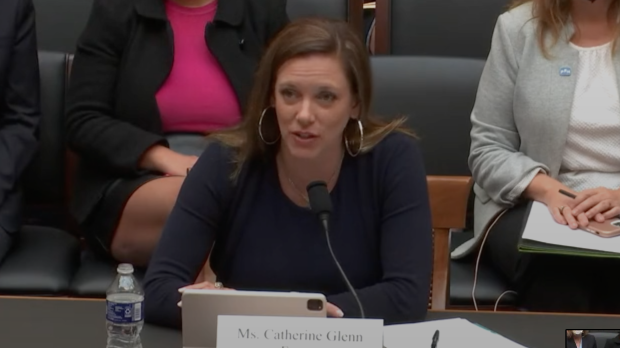Catherine Glenn Foster serves as President & CEO of Americans United for Life, which, in its own words, “works to advance the right to life in culture, law and policy.” She spoke with Aleteia in the wake of the U.S. Supreme Court’s Dobbs v. Jackson decision overturning Roe v. Wade and Planned Parenthood v. Casey, sending the decision on abortion’s legality back to the state level.
Foster shared her insights on what lies ahead for the pro-life movement, saying it will need to work even harder than before to protect unborn life, to defend pro-life legislation from challenges and to work to pass protections in states where abortion will remain legal.
What will the US look like now, in broad terms, with the overturning of Roe and Casey?
We’re looking at a US where, not on day one – it’s going to take us a little time to get there – but once the dust is settled down, I think we’re going to have a US where there are protections that are enshrined in law for every mother and father and child in every state. And I think we’ll have a US where we’ll be building a future that transcends the violence of abortion and that allows everyone to thrive. That’s what we’ve been fighting for for 49 years – at AUL for 51 years. We’re looking towards a future where abortion violence is abolished and where we’re focused on providing mothers and children with the absolute best care and support throughout their lives for a future of thriving. That’s what’s critical here.
I think it will take a little bit of time to get there. We know that we have a handful of states that have already ended abortion within their borders. We know there are states that are running as fast as they can in the other direction, tragically – states like New York, California, that are trying to even go beyond what Roe had contemplated.
And then most states are in the middle. They’re going to take this opportunity, they’re going to take a look at the needs of their state. They’re going to take a look at solutions that are life-affirming and uplifting and that really transcend the entire politics of partisanship that have poisoned our culture and our political system and process for decades. So they’re going to look to maybe limit abortions by gestational age; they’re going to look to health and safety regulations and standards and true informed consent in making sure that women get all the information that they need. We’re going to continue to work in those states for life, and we’re going to continue to work in the New Yorks and the Californias of the nation for life.
Do you see your work changing in any way now that Roe is overturned? Does your focus shift?
Our workload just tripled. But with that, it shifts a little bit, because for 49 years we’ve been working to overturn Roe. Well, that’s done. Roe had put a cap on the protections that the state could provide for women and for children, and that cap is gone.
So now we’re looking towards a future where every state can protect life at any gestational age, and if they can do that, then people can demand that our politicians do that, that our elected representatives are supporting life. So we can hold our elected officials accountable for what they say or don’t say, or what they do or don’t do on abortion and to protect women.
And I think we need to kind of look at it as a two-fold kind of process. We need to continue to work in the law on abortion to limit it, restrict it, abolish it altogether. But we also need to be responding to the needs of women and mothers by building and supporting an abundant spectrum of life-affirming choices, because for too long abortion has been presented as this one-size-fits-all answer to pregnancy. You know – you’re pregnant and your busy at work: abortion. You’re pregnant and you have financial issues: abortion. You’re pregnant and you have a troubled relationship with the father: abortion. And that’s wrong. We need to do better. We can do better and we must do better than just swallow the talking points of multibillion-dollar corporate abortion interests. Every abortion is the story of a failure. Somewhere along the process, the woman was failed. Something has gone wrong. That’s not plan A, right?
So we’re going to work to see both Congress and state lawmakers work together to uphold a human right to life for America in every state.
Some of the reaction to the ruling on the pro-choice side has been quite extreme. Do you have a sense that the pro-life movement in general, and AUL in particular, might now be called to be reaching out much more to those who seem to have a very hardened heart in their embrace of abortion’s legality?
Oh, absolutely. Yes, that’s critical, because, you know, people are scared. And when you’re scared and feel trapped, bad things come out of that. When I was 19, I was scared and felt trapped, and that’s how I ended up having my abortion, because I didn’t know that there was any other option. I didn’t know if there were resources. I was just terrified.
So I understand that there’s a lot of fear, that there’s some anger. And fear comes out in weird ways.
There’s a lot we can do to help these people. We need to let the dust settle, take a minute, take a deep breath, relax, realize that there are better solutions. What we’ve seen from the other side, now and leading up to this, hasn’t been, “Okay, Roe may fall. Let’s work together for real solutions. Let’s work together to provide resources, empower women, and restore men to their rightful place.” That’s what we’re working towards. But what we’re seeing from them is just “Codify Roe. Let’s go put Roe into law, and more abortion, more abortion” all the time. That doesn’t get to the heart of the problem. That doesn’t answer women’s needs of why they seek abortion in the first place.
Unfortunately we’re seeing the anger bubbling up, we’re seeing attacks on churches, on pro-life pregnancy centers. Seeing that, it’s heartbreaking. It’s so deeply wrong. We need to be reaching out to these people in love and saying “No, we need to find a better way.”
Everyone comes at it from a unique background. Different people need different outreach. The young woman who’s scared needs a different kind of outreach than the person who’s scared and angry and is lashing out. But all of these people, we need to be explaining the truth about abortion, the truth about abortion law, and the truth about what it’s going to be like going forward. And the truth about our hearts of service and what we can do going forward to help women. And when that starts happening, I think all of this is going to die down. It’s been a rough couple of months for a lot of people, but this really is the dawn of a new era of hope in Ameria, and we just need to communicate that truth.
What are the prospects for Congress codifying Roe? And could Dobbs itself be challenged?
I’ve testified against the latest attempt to codify Roe in Congress – the Women’s Health Protection Act, which they’ve introduced a couple of times. It’s a terrible bill; it’s incredibly radical. It has nothing to do with health and protection. It does nothing for women. But that’s their attempt to codify and expand upon Roe – even more radical than Roe ever dreamed of being.
So we’re going to continue to be there every step of the way at the federal level, fighting back against those radical attempts to expand abortion. We’re going to be advancing pro-life measures at the federal level, and of course in the states. We’ve been there in the states for 51 years and will be there for the foreseeable future, for as long as it takes to ensure that every life is respected and protected, that every life is cherished and welcomed in law.
USA Today and the Arizona Republic did a study and found that of the hundreds of pro-life laws that have been passed over the decades, most were based on our model bills. We’re at the heart of most of them. We’re experienced and we’re ready for the next challenges.
Where will some of the biggest battles be fought on the state level?
I would almost say every state, because we have states like Missouri and Arkansas that are just all in, doing the right thing. But they’re going to have to defend their laws. They’re going to be under attack. We’re going to continue to push in those middle battleground states. We’re going to help the people of those states express their opinion and get their needs and their protections passed into law. But that’s going to be an effort.
And we’re going to be in those blue states. We have a blue state strategy and we’re going to do everything we can to educate, to push back, to defend life, because what the women in those states are going to be left with is no sanitation, no mandatory reporting in cases of statutory rape, not informed consent, no wait period, no nothing. They’re going to be like I was at age 19, where they ask to see an ultrasound, and there’s a good chance they’re denied, just like I was. That’s absolutely wrong. That’s not informed consent, and that’s not choice.
So we’re going to have to fight in all those kinds of states, plus at the federal level. It’s a tremendous day. We’re in a new season. But with that said, our workload just tripled, or quadrupled.
There is a lot of concern about women still being able to get abortion pills, which the FDA said can be taken in the first 10 weeks of pregnancy. What can be done about that?
There are so many problems with that. It’s not just pro-lifers; it’s any scientist, any American with a conscience who’s actually willing to face the truth. We know that the abortion pill carries a higher risk of sepsis, a higher risk of hemorrhage, than even surgical abortion. It is dangerous. And then if you pair that with telemedicine, where the woman isn’t even seen and examined in person, there’s no ultrasound to determine how far along she is. Women don’t always know just how far along we are. And even if we do, it’s a big leap there. You have to have scientific, medical verification of how advanced this pregnancy is. You have to verify that the pregnancy is not ectopic. That’s a life-threatening condition. All of these problems that can arise that are just overlooked when we’re just shipping abortion pills to young women in the mail: who knows who’s receiving them? Who knows how they’re being taken? It’s a very dangerous proposition.
So we’re looking at any and all steps we can take to prevent that and make sure that in the states where that will still be available, wherever it’s applicable, that at least women are being examined in person, at least they understand the implications, they understand what that looks like going forward, and we’re going to do all we can to prevent that telemedicine chemical abortion, along with all chemical abortions.
What effect might the Dobbs decision have on the culture in general, to have the “law of the land” be at least neutral on abortion, and in some states clearly coming down on the side of life?
Most Americans, to the extent that they think about abortion at all – and a lot of Americans don’t – agree, because it’s what’s moral, it’s what’s logical, it’s the heart of the natural law; it’s within our hearts and our souls. Most Americans agree, when it comes to protecting life — we just did a survey with YouGov, and found that 90% of Americans recognize that abortion ends the life of a human being in their womb, prior to birth. That’s an astounding number, and it really shows that Americans are not as divided as people may seem to want us to think that they are. Our politicians in a lot of cases are, some people at the highest levels, mainstream media. But most Americans want at least major rollbacks on legalized abortion.
And so, even though listening to the mainstream media talking points, we have seen sways, if you will, we’ve seen some pivoting, when there’s been any kind of law on abortion passed. New York passed its reproductive health act a couple of years ago, and at that point we saw a dramatic shift in the percentage of New Yorkers who call themselves pro-life, who looked at that law and said, “If that’s what pro-choice means, I want no part of it. It’s radical.” So we saw a dramatic shift in New York.
Similarly, on the other side of the coin, after Alabama passed its pro-life law, we saw another shift, back in the other direction, because people were like “Whoa, what does this mean?” There’s fear-mongering out there. People are saying scary things about what this means. “Can a woman whose life is actually in danger get the medical care she needs?” Of course she can. But people weren’t saying that; there’s a lot of misinformation out there.
But, you know, most Americans are on the side of life. The more Americans learn about abortion, talk about abortion, think about abortion, get to the moral heart of it, talk about the actual procedures, the more they realize it’s an abomination, and in fact you even look at the studies in the survey, and a third of Democrats, the party that is calling for more abortion, call themselves pro-life, maybe not for a complete abortion abolition, but they certainly want way more restrictions than Roe allowed for, and even most states would currently contemplate.



